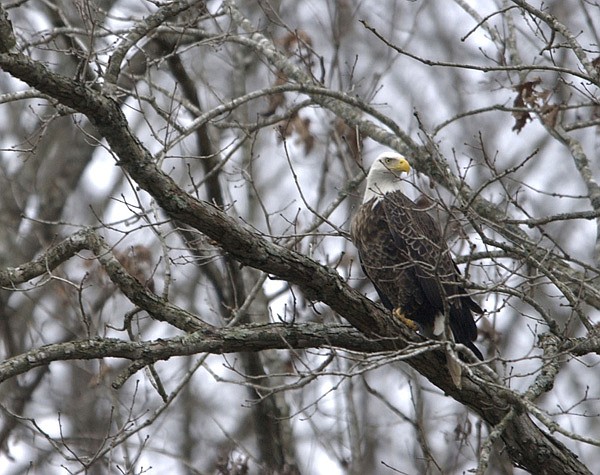Fine, Feathered Cruise
HOBBS BOAT TRIPS LET PASSENGERS SOAR WITH THE EAGLES
Eagles wintering over at Beaver Lake can be observed from a pontoon boat when the annual Eagle Watch Tours, sponsored by Hobbs State Park-Conservation Area, begin Saturday.
Wednesday, October 31, 2012
Bald eagles are migrating south into the Ozarks just in time for the Hobbs State Park-Conservation Area eagle watch tours on Beaver Lake.
Cruises start Saturday aboard the park’s 20-passenger pontoon boat that departs from Rocky Branch Marina. All cruises begin at 3 p.m.
Reservations are required and can be made by calling the park visitor center at 789-5000or stopping by the center on Arkansas 12 one-quarter mile east of War Eagle Road.
Cost is $10 for adults, $5 for children age 6 through 12. Kids under 6 ride free. The fee is paid at the visitor center, not the marina.
Trips set sail most Saturdays, Sundays and Wednesdays through February. Tuesday and Friday trips are occasionally scheduled.
Passengers are welcome to bring snacks and nonalcoholic drinks. There is no restroom on the boat.
A guide is on board each cruise to help passengers spot bald eagles and to answer questions about Beaver Lake and its wildlife. Binoculars are provided, or passengers may bring their own.
Bald eagles are already arriving, said Josephine Barry at the Hobbs State Park information desk.
“Quite a few have already been seen at the lake. They seem to be coming in a little early this year,” she said. “Normally we don’t see many until November.”
Beaver Lake is the winter home to about 300 bald eagles. Most migrate here from the Great Lakes region, where they nest and raise young. They fl y back north starting in mid-February.
A few resident eagles stay in the lake area year-round. Thereare three active bald eagle nests on Beaver Lake, and adult bald eagles are successful at raising young each year. It’s possible, though rare, to see bald eagles at the lake during summer.
Boat trips head into the Van Winkle Hollow arm of Beaver Lake. It’s attractive to eagles because it’s isolated, with no houses or docks in the southern half of the 3-mile-long arm. Passengers see adult bald eagles, which display a white head and white tail, and juveniles that are a mottled brown color.
The white plumage doesn’t develop until eagles reach mating age at 4 to 5 years.
There are other birds to see on the tours in addition to eagles, said Rachel Diersen, an interpretive naturalist at Hobbs. Passengers might see ducks, geese, loons, herons, gulls or kingfi shers.
Deer are sometimes on the lake shore.
“One time we saw a coyotechasing a deer,” Diersen said.
But it’s eagles that people want to see. Diersen said two to three bald eagles are usually seen, but some trips encounter 15 to 30 eagles, depending on the weather.
Barry, at the information desk, said chilly, overcast days are best for seeing lots of eagles. The colder and nastier, the better - to a point. Cruises are canceled if the weather is extreme. Wind is the main factor.
“We can go out in the rain, but we can’t go out in a big wind,” Barry said.
If a trip must be canceled, passengers can book another date or get their money back.
Sound advice is to dress for weather that is 20 degrees colder than it is on land. The temperature always feels colder on the lake, and there’s a wind chill factor in the moving boat.
Fall and winter are fine seasons to visit Beaver Lake, eagles or not. Few if any boats are seen. It’s quiet, and the air is crisp and invigorating.
Life, Pages 6 on 10/31/2012
